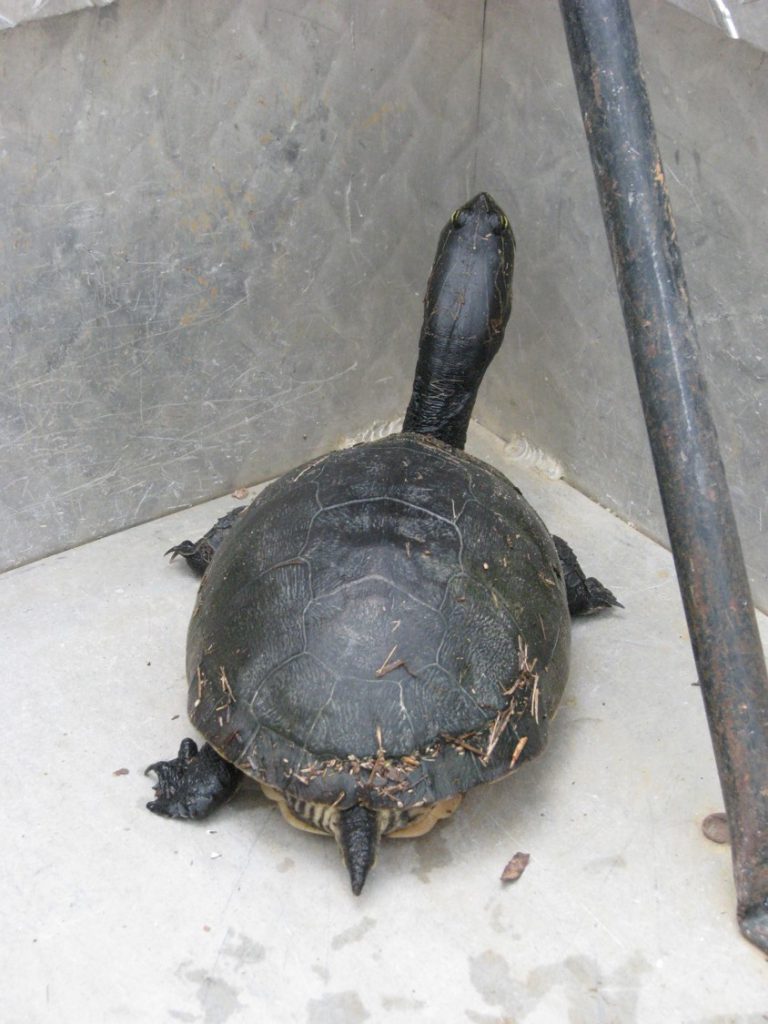I recently wrote an article introducing some to a panhandle turtle that is not as well-known as most – the map turtles. This week I am going to write about another lesser-known species – the chicken turtle.
Some may say “is there a turtle REALLY called the chicken turtle?” and “if so, why is it called that?”.

The answer is yes… there is a turtle called a chicken turtle (Deirochelys reticularia). It is a member of the family Emydidae, which is the family where you find the different pond, river, and lake turtles, as well as the terrapins and box turtles. The name chicken may refer to the unusually long neck this turtle has, but more than likely it comes from an early description of the species in the 1800s that stated it “taste better than the cooters – more like chicken.”
The reason some are not aware of this animal is because of their habitat selection, behavior, and low population densities. Though they are aquatic turtles, they are very selective of which waterbodies they inhabit and may spend months out of the water in upland forested areas.
Chicken turtles seem to prefer quiet shallow waterways where the water is clear, or at least tannic, they dislike turbid/muddy systems. They avoid rivers, creeks, streams, and many lakes. Most of the waterways they inhabit are ephemeral, meaning they dry up during part of the year. During these dry times they, again, seek upland habitats and have been found as far as a 150 meters (510 feet) from any water source. The females appear to avoid their landward movements during the peak of summer. However, males are opposite – moving upland during summer and not as common during the winter months. These overland treks by the females seem to be associated with nesting activity. Where the upland movement of males seem to focus on finding new waterways after the ones they were in have become dry.
Their distribution extends across the southern coastal plains. From Virigina, throughout the deep south, west to Texas, and north to Arkansas. They are found throughout the state of Florida. There are three recognized subspecies –
The Eastern Chicken Turtle (Deirochelys reticularia reticularia)– is found from southern Virginia, coastal Carolinas, southern Georgia, Alabama, Mississippi, and the Florida panhandle. In addition to the long neck, the carapace is sort of “domed” shaped. Terms like “helmet” and “pear” shaped have been used as well. The coloration is dark gray to olive green with a distinct yellow line pattern that resembles a cast net covering the carapace. The plastron is solid yellow to a yellow-orange color. The underside of the bridge (portion of the shell connecting the carapace to the plastron) usually has two dark blotches. This subspecies often has dark spots along with the dark bars on the underside of the bridge.
The Florida Chicken Turtle (D. r. chrysea) – is found in the Florida peninsula. The dark markings on the underside of the bridge are absent in this subspecies.
The Western Chick Turtle (D. r. miaria) – is found west of the Mississippi River in Louisiana, Texas, and Arkansas. Its plastron is not solid yellow, but rather has dark markings within the seams of the plastron scutes.
Chicken turtles are of average size, with carapace lengths near nine inches, and (as with many turtles) females are larger than males. The young and males feed on the larva of such things as dragonflies and damselflies, as well as other aquatic bugs. Crayfish seem to be a particular favorite, especially with the larger females.
Mating occurs underwater. Nesting begins in summer and continues through fall and winter. Two to 19 eggs are deposited but the average is around 10/clutch, and she will lay more than one clutch each year.
Threats to their populations include being hit by cars while crossing highways. Their overland treks enhance this problem. Other threats include predation by raccoons and alligator snapping turtles, the pet trade, and it was once a food item – “taste like chicken”. With low densities of chicken turtles, this may be the result of overharvesting years ago. Potential threats include habitat loss and invasive species are very likely.
Statewide turtle surveys suggest that chicken turtles are found but their abundance/density is low compared to other species. It is exciting for folks exploring both our ephemeral wetlands and upland areas to find it. Hopefully, one day, you will encounter one as well.
- Our Environment: Part 11 – We Need Water - July 7, 2025
- Our Environment: Part 10 – Improving Agriculture - June 20, 2025
- Marine Creatures of the Northern Gulf – Snails and Slugs - June 20, 2025
